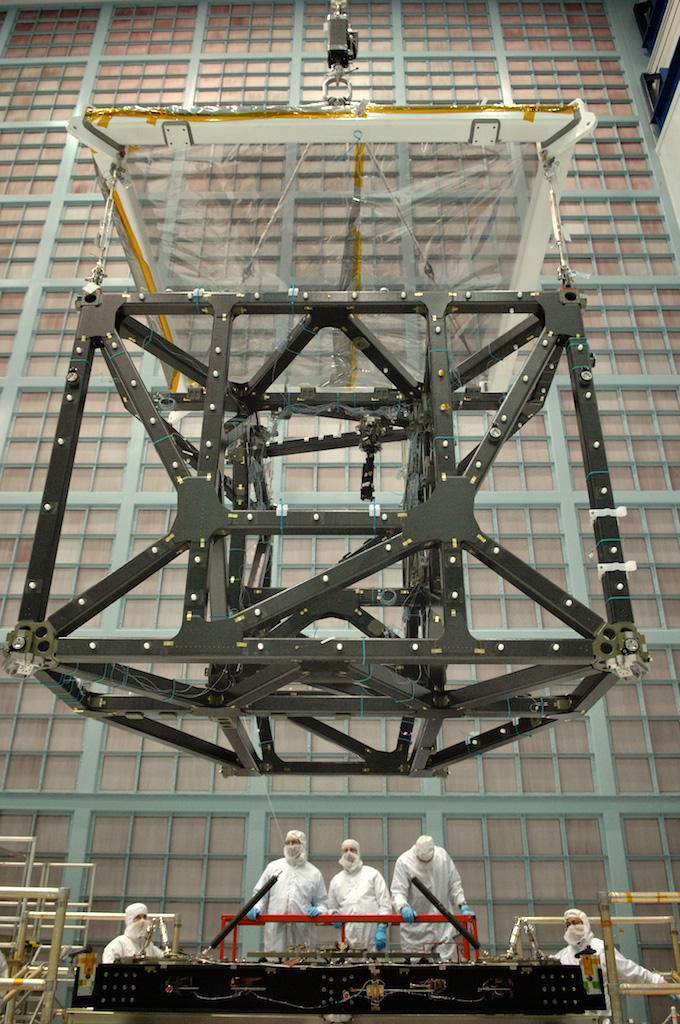This is the third installment in a four-part series of conversations with Paul Geithner Deputy Project Manager – Technical for Webb telescope at NASA’s Goddard Space Flight Center in Greenbelt, Maryland about different aspects of the Webb.
The James Webb Space Telescope will gaze into the universe in infrared light and look farther back in time than previous telescopes, allowing scientists to look through cosmic dust to see stars forming. Paul discusses how the Webb telescope is coming together.
Q: The James Webb Space Telescope continues to come together, but what needs to happen between now and launch?
Paul: We plan to launch in 2018. There are still a lot of tests to be conducted, and many components will be traveling to different places between now and then as part of this testing and assembly process.
Q: What progress is planned for 2015?
Paul: The Webb telescope is being built-up and tested now, after many years of technology development and design. Now through the end of 2015, the actual telescope structure gets populated with mirror segments, and the instrument module, or the “heart” of the telescope, gets some work done on it, gets shaken on a big vibration table that simulates the rigors of launch, and goes into the vacuum chamber again for another roughly 4-month duration cold vacuum test.
In the meantime, the sunshield and spacecraft bus are being fabricated and assembled and tested, as are many large pieces of test equipment.
More specifically, the Webb telescope program’s next big steps in 2015 include 1) change out of some key components of the Integrated Science Instrument Module (ISIM) prior to further testing, 2) start of assembly of the actual flight telescope, and 3) continued construction of the spacecraft bus and sunshield. The most prominent key components being changed-out on the instrument module are the near-infrared detectors in the three near-infrared instruments. Right now, the near-infrared instruments have been removed from the module and are having their detectors changed-out at Goddard.
The flight telescope structure will arrive at Goddard this summer and the flight mirrors will be installed on it the rest of 2015. Meanwhile, the spacecraft bus and sunshield continue to be put together at Northrop-Grumman in California. 4) Another significant set of activities in 2015 is testing of test equipment at Johnson Space Center in preparation for testing of the integrated telescope and instrument module in 2017.
Also a highlight at Goddard recently has been rehearsing telescope assembly using the prototype “Pathfinder” telescope, in prep for actual flight telescope assembly in 2015. The Pathfinder shipped to Johnson at the beginning of February and will be used in precursor tests leading up to OTIS (Optical Telescope Element plus ISIM) testing.
https://youtu.be/bTxLAGchWnA
March 2014 animation showing the James Webb Space Telescope deployment timeline post launch.
Credits: Northrop Grumman
Video on the JWST site
Q: What’s planned for the Webb telescope during 2016 and 2017?
Paul: The telescope and instrument module will be put together to form OTIS and be shaken at NASA Goddard in 2016, and then tested as one unit inside an enormous vacuum chamber known as “Chamber A” at NASA’s Johnson Space Center (JSC) in Texas in 2017. A relic of the Apollo era, Chamber A has been refurbished as a precision cryo-optical test facility for the Webb telescope. Right now our team is busy at Johnson testing and wringing-out test equipment in multiple cryogenic temperature vacuum tests prior to testing the flight OTIS itself.
Meanwhile at Northrop-Grumman in California, the sunshield and spacecraft will be assembled and tested. Once OTIS is done being tested at JSC, it will be transported to Northrop-Grumman and assembled with the combined sunshield and spacecraft to form the Webb telescope observatory.
Q: What is supposed to happen during 2018, the year of launch?
Paul: After a final round of tests at the observatory level in 2018, the Webb telescope will be shipped from Northrop-Grumman to French Guiana in South America and launched into space aboard an Ariane 5 rocket provided by the European Space Agency.
Q: Where will the Webb telescope orbit once deployed?
Paul: The Webb telescope will accompany the Earth in orbit around the Sun at a location about 1 million miles away from Earth in the midnight sky (i.e., about 4 times more distant than the Moon—in the direction opposite the Sun), go through a commissioning period lasting about 6 months, and then operate as a science facility for astronomers world-wide for at least 5 years.
The Webb telescope is the world’s next-generation space observatory and successor to NASA’s Hubble Space Telescope. The most powerful space telescope ever built, the Webb telescope is designed to observe the most distant objects in the universe, provide images of the first galaxies formed and study unexplored planets around distant stars. The Webb telescope is a joint project of NASA, the European Space Agency and the Canadian Space Agency.
For the Webb Conversations#1: Components, Structure of NASA’s James Webb Space Telescope, visit: https://www.nasa.gov/content/goddard/webb-conversations-components-structure-of-nasa-s-james-webb-space-telescope/
For Webb Conversations#2: It’s All About Infrared – Why Build the James Webb Space Telescope: https://www.nasa.gov/content/goddard/webb-conversations-its-all-about-infrared-why-build-the-james-webb-space-telescope
For more information about the James Webb Space Telescope visit: www.jwst.nasa.gov or www.nasa.gov/webb
Rob Gutro
NASA’s Goddard Space Flight Center



























